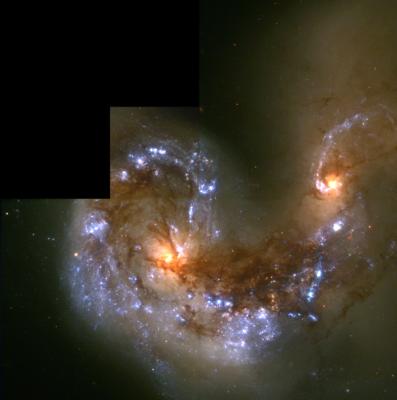







| BOOKS | F. A. Q. | ARTICLES | TALKS | ABOUT KEN | DONATE | BEYOND OUR KEN |
|---|
By Ken Croswell
Published on ScienceNOW (August 26, 2010)

Credit: Brad Whitmore (STScI) and NASA
Don't tell Adam Smith, but galaxy collisions seem to be agents of cosmic socialism. A new study finds that they cause galactic regions rich in oxygen, iron, and even gold to mix with those that are impoverished, thereby making the rich poorer and the poor richer.
In astronomy, any element heavier than helium is called a metal, so while your chemist friends certainly don't consider oxygen a metal, astronomers do. These metals are vital for terrestrial planets and life. Not only do we breathe the universe's most abundant one--oxygen--but huge quantities of oxygen are also locked in the silicate rocks beneath our feet. In most large galaxies, oxygen and other metals abound at the center and decline toward the galaxy's edge. That's because most metals are forged by stars, which congregate at the galaxy's core. Our own Milky Way's disk, for example, has a strong metallicity gradient: travel 10,000 light-years away from the Galactic center and the iron abundance drops an average of 35 percent. However, theorists have expected that galaxy collisions should disrupt such gradients by mixing metal-poor gas from a galaxy's outskirts with metal-rich gas at its center.
Now astronomers Lisa Kewley, David Rupke, and H. Jabran Zahid of the University of Hawaii, Honolulu, and their colleagues have seen this process at work. They measured the oxygen abundances of star-forming regions in eight large spiral galaxies that resemble the Milky Way--but with one key difference: they're all colliding with other large spirals. In all eight, the oxygen gradient is much shallower--that is, the drop in oxygen farther away from the center is lower--than in the Milky Way. "We're surprised that absolutely every single one of them has this flatter gradient," Kewley says. "It's much more widespread than we expected." The study will appear in a future issue of The Astrophysical Journal Letters.
"It's really fantastic work," says astronomer Paul Torrey of the Harvard-Smithsonian Center for Astrophysics in Cambridge, Massachusetts. "They did a set of really beautiful observations. The trends that they're seeing are quite clear." The study, he says, is "a very key contribution to understanding how galaxies change morphologically during their interaction." It may also provide a glimpse of what's ahead for our Galaxy: even the Milky Way may go socialist, billions of years from now, if it smashes into the giant spiral in Andromeda.
Ken Croswell earned his Ph.D. for studying the Milky Way and is the author of Magnificent Universe and The Alchemy of the Heavens.
"Elegant and eloquent."--Kathy Sawyer, Washington Post. See all reviews of Magnificent Universe here.
"An engaging account of the continuing discovery of our Galaxy...wonderful." --Owen Gingerich, The New York Times Book Review. See all reviews of The Alchemy of the Heavens here.
| BOOKS | F. A. Q. | ARTICLES | TALKS | ABOUT KEN | DONATE | BEYOND OUR KEN |
|---|